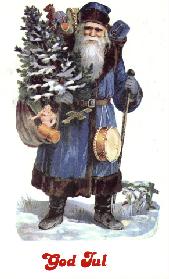
St. Nicholas died about 350. He lived in Asia Minor. He became and Abbott and then a Bishop. There are many stories about him. He is buried at Bari. He is the patrons St. of Russia, Greece, and many cities in Europe. He is regarded as a special protector maidens, children, merchants and sailors. Scholars are also under his protection. He even came to be regarded as the patron of Robbers From some adventures with thieves, whom he compelled to return some stolen goods. In the Middle Ages thieves were called clerks of St. Nicholas. He became to patron and guardian of children when he we restored to life three children and, sons of rich parents who had been murdered. The legend of giving presents is told in a story about a Nobleman with three daughters who was so poor that he was unable to give them a Dowry. St. Nicholas heard in about this and secretly went to the nobleman's house at night to, he threw at purse of gold into an open window. And this fell at the feet of the father who used it for his eldest daughter. On the second night to St. Nicholas threw a second to purse for the second daughter; and on the third night Another St. Nicholas for the third daughter. This occasion the man caught St. Nicholas into the act and held him up by his robe. St. Nicholas promised the nobleman that he would not to all anyone. From this it became the custom for the all the members of the house to place presents in the shoes or stockings of the children on discovering them in the morning were pleased to thank St. Nicholas.
While making a trip to the hallway tandem he rose to a great Storm to disappear and became the patron St. mariners.
This celebration of St. Nicholas day was important for a longtime in Holland and Germany but more people were celebrating Christmas day and the importance of Christmas trees have caused the St. Nicholas traditions to be absorbed into Christmas.
On at the eve of his festival with a, St. Nicholas makes his tour to all the houses when he is gone the children place shoes or stockings for the gifts which St. Nicholas is expected to to let fall down the chimney. Sometimes St. Nicholas came on a Gray horse or white donkey home. For him the children put out the water or carrot and hay. In the morning it is evident that St. Nicholas had been present and replacing the carrots that children found sweets and play things for doors children who have been good and studied during the year.
St. Nicholas his robe enables him to travel from place to plays instantly. In Holland he is supposed to use a horse for his journey at night over the roofs of the houses. The Dutch settlers brought St. Nicholas customs to New York and then it spread in to other parts of the United States. In America changes were made in his appearance, and he became a very much at home.
The Story of the Christmas Tree
The tree, used as a symbol of life, is a tradition older than Christianity and not exclusive to any one religion. It's a part of our holiday customs that engages not only our senses of sight, touch, and smell, but also our sense of tradition, hope and good will.
Long before there was a Christmas, Egyptians brought green palm branches into their homes on the shortest day of the year in December as a symbol of life's triumph over death.
Romans adorned their homes with evergreens during Saturnalia, a winter festival in honor of Saturnus, their god of agriculture. Druid priests decorated oak trees with golden apples for their winter solstice festivities.
In the middle ages, the Paradise tree, an evergreen hung with red apples, was the symbol of the feast of Adam and Eve held on December 24th.
The first recorded reference to the Christmas tree dates back to the 16th century. In Strasbourg, Germany (now part of France), families both rich and poor decorated fir trees with colored paper, fruits and sweets. The retail Christmas tree lot also dates back that far - in those times, older women would sell trees harvested from nearby forests.
The tradition spread through Europe and was brought to the United States by German settlers and by Hessian mercenaries paid to fight in the Revolutionary War. In 1804 U.S. soldiers stationed at Fort Dearborn (now Chicago) hauled trees from surrounding woods to their barracks at Christmas.
The popularity of the Christmas tree then proliferated. Charles Minnegrode introduced the custom of decorating trees in Williamsburg, Virginia in 1842. In 1851, Mark Carr hauled two ox sleds loaded with trees from the Catskills to the streets of New York and opened the first retail lot in the United States.
Franklin Pierce, our 14th President, brought the Christmas tree tradition to the White House. In 1923, President Calvin Coolidge started the National Christmas Tree Lighting Ceremony now held every year on the White House lawn.
Since 1966, members of the National Christmas Tree Association have presented a beautiful, fresh Christmas tree to the President and first family. This tree is displayed each year in the Blue Room of the White House.
Thank You to the National Christmas Tree Association
| In the Seventeenth century the Pilgrims did not celebrate Christmas. December 25 was a workday. |
| In the late 1700's, Christmas was once again a happy holiday. The Colonists decorated their fireplaces with greenery, sung carols, and feasted. No one, however, had a Christmas tree. |
| In 1823 Clement Moore wrote the poem "A Visit From St. Nicholas." Saint Nicholas or Santa Claus began to play a big part in the celebration of Christmas. |
| In the 1840's. German immigrants introduced the Christmas tree. This decoration became a major part of the Christmas tradition. |
Home Jacksons Our Kitchen Grandmothers Attic Tales of our Past
Single Parents Recovery Vietnam Disabilities
Christmas Teens Page Sams Sports Page Sarahs Page